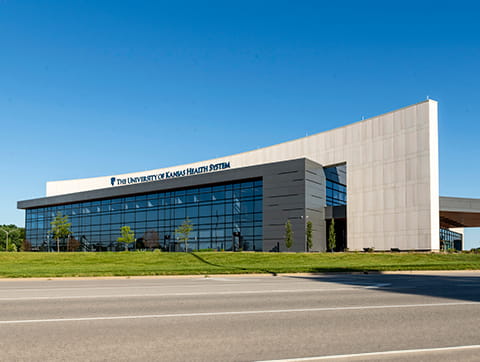July 18, 2023
Who would have thought the phrase “bricks and mortar” would pack such a punch?
For years, we’ve been using that phrase to mean an actual building, not something you get online. Plus, with all the glass and steel structures around, I’m not sure there were very many actual bricks going up anyway.
Looking at the renderings of The University of Kansas Cancer Center’s recent proposal, it’s certain our latest “bricks and mortar” project will be gleaming, state-of-the-art and – here, I’m purposely not shying away from a bold statement – region-changing. Ignited by a very generous gift and some federally allocated funds thanks to a passionate United States senator.
“We believe The University of Kansas Cancer Center is poised to change cancer research and care for generations,” Charlie Sunderland told an audience when his family’s Sunderland Foundation made their largest gift ever – $100 million – to a new building at our 39th and Rainbow campus in Kansas City that will put those caring for cancer patients right down the hall from those doing research and teaching about it.
“Giving people the opportunity to receive such a high level of quality cancer treatment close to home is a gift like no other. I’m grateful for the foundation’s role in making this possible.”
A place for collaboration
We’re beyond grateful. As in – many, many of us who attended the June 27 announcement won’t be around, or at least working, when generations to come benefit from this project. You know, plant a tree for someone you’ll never meet so they can enjoy the shade it gives long after you’re gone.
“We do big things in Kansas City, due in large part to the generosity and vision of people like Charlie and (his brother) Kent Sunderland and the Sunderland Foundation,” said Bob Page, president and CEO of The University of Kansas Health System. This was the largest gift the health system or the university had ever received.
When it comes to buildings – brick, mortar, glass and steel – it’s fascinating to study their use. As an example, longtime Kansas City mainstay Sprint, which merged with T-Mobile, at one time had dozens and dozens of buildings spread throughout the city before building a new world headquarters in Johnson County. (Coincidentally, its original “world headquarters” is now the health system’s Westwood Campus at Shawnee Mission Parkway and Rainbow Boulevard.)
The University of Kansas Cancer Center is not a single building either but a collection of places where scientists research, educators teach and clinicians treat. It’s long been the goal to find that one place where they could all collaborate. There’s no getting around it; being able to walk down the hall to confer will lead to breakthroughs.
Multiple cancer locations will remain. And there are no guarantees, of course. But not one person at the announcement thought the long game was anything less than eventual cure for cancer.
Giving people the opportunity to receive such a high level of quality cancer treatment close to home is a gift like no other ... I’m grateful for the foundation’s role in making this possible.
Charlie Sunderland, Sunderland Foundation
A destination of hope
“Our vision is for The University of Kansas Cancer Center to be a beacon of hope and a global destination for both those with cancer and for scientists and clinicians seeking to cure cancer,” said Dr. Roy Jensen, cancer center director. “This building will be a hub that brings together leading-edge patient care and innovation as we seek to transform both cancer care and cancer research in our quest to cure cancer – together.”
Groundbreaking won’t be for some time yet, and the center (with a successful capital campaign) will be built in phases. The announcement comes just less than a year after the last cancer milestone within the KU umbrella. Just last July, the cancer center received “comprehensive” designation from the National Cancer Institute.
That got everybody’s attention, locally and nationally. It just so happened that Dr. Lawrence Tabak, acting director of the National Institutes of Health, found himself in Kansas City the day of the announcement and joined the dais of speakers. He spent much of the day with our leadership and U.S. Sen. Jerry Moran of Kansas. Moran’s office announced a few months ago he had secured $43 million in funding for the project.
With $143 million in the bank and more commitments known but not announced yet, these are exciting times. Bricks, mortar, steel and glass are pretty on paper and should be breathtaking against the Kansas City skyline.
The real beauty is the hope that exists for the person we don’t know who needs cancer care. They haven’t been born yet.





